Run AI-enabled Jakarta EE and MicroProfile applications with LangChain4j and Open Liberty
- August 12, 2024
- 4742 Unique Views
- 6 min read
- Creating the LangChain4j AI service
- Externalizing the configuration
- Communicating between the client and LLM
- Enabling metrics
Artificial Intelligence (AI) is an exciting and disruptive field that is already transforming businesses, and even entire industries, by enabling automation, improving decision-making and unlocking new insights from data.
With the rise in large language models (LLMs) such as ChatGPT, there is a significant shift in the performance of AI and its potential to drive enterprise value. So, how will this impact on software development and the creation of cloud-native Java applications for enterprises?
In this post, we'll explore what LLMs are and how to use them in Java applications. We'll also get started using them in an example Jakarta EE/MicroProfile app.
- Find out what LLMs are
- Explore app frameworks that simplify the use of LLMs
- Discover how to use LangChain in Java applications
- Try out the jakartaee-microprofile-example application
- Learn how this sample application works
What are LLMs?
A language model is a model of natural language based on probabilities. They are able to generate probabilities of a series of words together. Large language models (LLMs) are simply language models that are categorized by their large size.
They are trained on immense amounts of data, possibly billions of parameters, by using self-supervised and semi-supervised learning techniques. This training enables them to generate natural language and other types of content to perform a wide range of tasks.
See the following introductory video for more information on LLMs, including what they are, how they work, and their business applications.
You can find LLMs in the service offerings of almost all of the major cloud service providers. For example, IBM offers models through its WatsonX services, Microsoft Azure offers LLMs like Llama 2 and OpenAI GPT-4, and Amazon Bedrock offers models from a range of AI companies.
How can we take advantage of LLMs in Java applications?
Integrating AI/LLM capabilities into an application can be challenging. The open source LangChain framework was developed in 2022 to help streamline the process of creating generative AI apps.
LangChain provides tools and abstractions to improve the customization, accuracy, and relevancy of the information the models generate. For example, developers can use LangChain components to build new prompt chains or customize existing templates.
LangChain also includes components that allow LLMs to access new data sets without retraining and organizes the large quantities of data these models require so that they can be accessed with ease.
Although LangChain is primarily available in Python and JavaScript/TypeScript versions, options are available to use LangChain in Java applications through community projects like LangChain4j. LangChain4j APIs can help integrate LLMs into your Java application for different AI platforms, such as OpenAI and Hugging Face.
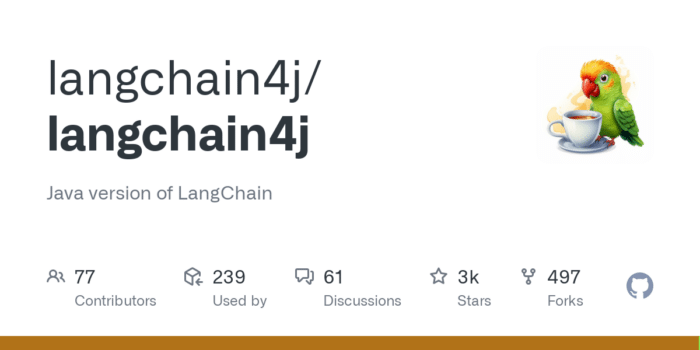
How to use LangChain4j in a Jakarta EE and MicroProfile application
Langchain4j has a useful open source langchain4j-examples GitHub repository where it stores example applications. However, we could not find any examples showcasing how you could experience these AI technologies in a Jakarta EE or MicroProfile based application.
So, we decided to build one ourselves called jakartaee-microprofile-example, which can now be found in this langchain4j-examples GitHub repository. This demo application highlights how to use LangChain4j APIs in an application by using Jakarta EE and MicroProfile on Open Liberty.
Try out the jakartaee-microprofile-example application
To see how you can apply LangChain4j to your own Jakarta EE and MicroProfile applications, check out this example project for yourself.
Prerequisites
Before you clone the application to your machine, install JDK 17, and ensure that your JAVA_HOME environment variable is set. You can use the IBM Semeru Runtime as your chosen Java runtime.
This runtime offers performance benefits from deep technology investment in projects such as Eclipse OpenJ9 and is available across a wide variety of hardware and software platforms. To find out more about IBM Semeru Runtime, see Open Liberty and Semeru Runtimes, cloud-native performance that matters.
The application uses Hugging Face. You need to get a Hugging Face API Key:
- Sign up and log in to https://huggingface.co
- Go to the Access Tokens page
- Create an access token with
readrole
To access the repository remotely, install Git if you haven't already. You can clone the langchain4j-examples GitHub repository to your local machine by running the following command:
git clone https://github.com/langchain4j/langchain4j-examples.git
Environment setup
To run the application, navigate to the jakartaee-microprofile-example directory:
cd langchain4j-examples/jakartaee-microprofile-example
Set the following environment variables:
export JAVA_HOME=<your Java 17 home path> export HUGGING_FACE_API_KEY=<your Hugging Face read token>
Start the application
To start the application, use the provided Maven wrapper to run Open Liberty in dev mode:
./mvnw liberty:dev
After you see the following message, the application is ready:
************************************************************************ * Liberty is running in dev mode. * Automatic generation of features: [ Off ] * h - see the help menu for available actions, type 'h' and press Enter. * q - stop the server and quit dev mode, press Ctrl-C or type 'q' and press Enter. * * Liberty server port information: * Liberty server HTTP port: [ 9080 ] * Liberty server HTTPS port: [ 9443 ] * Liberty debug port: [ 7777 ] ************************************************************************
To ensure that the application started successfully, you can run the tests by pressing the enter/return key from the command-line session. If the tests pass, you can see output similar to the following example:
[INFO] ------------------------------------------------------- [INFO] T E S T S [INFO] ------------------------------------------------------- [INFO] Running it.dev.langchan4j.example.ChatServiceIT [INFO] ... [INFO] Tests run: 1, Failures: 0, Errors: 0, Skipped: 0, Time elapsed: 0.439 s... [INFO] ... [INFO] Running it.dev.langchan4j.example.ModelResourceIT [INFO] Tests run: 3, Failures: 0, Errors: 0, Skipped: 0, Time elapsed: 0.733 s... [INFO] [INFO] Results: [INFO]
Access the application
After the application is running, you can access it through a browser of your choice at http://localhost:9080/ and start experimenting with it.
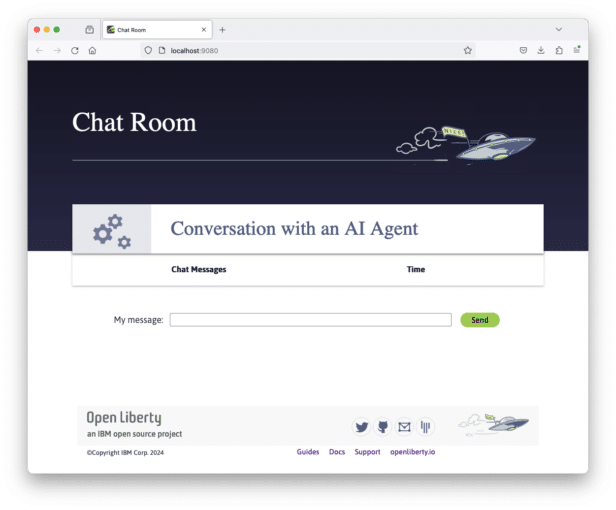
You can type in any text that you want to chat with the AI agent. Here are some suggested messages:
What is MicroProfile?Which top 10 companies contribute MicroProfile?Any documentation?
How does the application work?
The application demonstrates how to use the LangChain4j APIs, Jakarta Contexts and Dependency Injection, Jakarta WebSocket, MicroProfile Config, and MicroProfile Metrics features.
Creating the LangChain4j AI service
The application uses the HuggingFaceChatModel class to provide the model for building the AI service.
See the src/main/java/dev/langchain4j/example/chat/ChatAgent.java file.
public Assistant getAssistant() {
...
HuggingFaceChatModel model = HuggingFaceChatModel.builder()
.accessToken(HUGGING_FACE_API_KEY)
.modelId(CHAT_MODEL_ID)
.timeout(ofSeconds(TIMEOUT))
.temperature(TEMPERATURE)
.maxNewTokens(MAX_NEW_TOKEN)
.waitForModel(true)
.build();
assistant = AiServices.builder(Assistant.class)
.chatLanguageModel(model)
.chatMemoryProvider(
sessionId -> MessageWindowChatMemory.withMaxMessages(MAX_MESSAGES))
.build();
...
}
Through the customized Assistant interface, the application can send messages to the LLM by its chat() method.
interface Assistant {
String chat(@MemoryId String sessionId, @UserMessage String userMessage);
}
Externalizing the configuration
An API key is required to access the model. For security purposes, the key is not hardcoded in the code. The application externalizes the API key and the LangChain4j model properties with the MicroProfile Config feature that helps the application to run in different environments without code changes. You can learn more from the External configuration of microservices document.
See the src/main/java/dev/langchain4j/example/chat/ChatAgent.java file.
@Inject @ConfigProperty(name = "hugging.face.api.key") private String HUGGING_FACE_API_KEY; @Inject @ConfigProperty(name = "chat.model.id") private String CHAT_MODEL_ID; @Inject @ConfigProperty(name = "chat.model.timeout") private Integer TIMEOUT; @Inject @ConfigProperty(name = "chat.model.max.token") private Integer MAX_NEW_TOKEN; @Inject @ConfigProperty(name = "chat.model.temperature") private Double TEMPERATURE; @Inject @ConfigProperty(name = "chat.memory.max.messages") private Integer MAX_MESSAGES;
To fine tune the LangChain4j model or even try out another LLM, you simply update the values in the src/main/resources/META-INF/microprofile-config.properties file or provide them through the environment variables.
hugging.face.api.key=set it by env variable chat.model.id=NousResearch/Nous-Hermes-2-Mixtral-8x7B-DPO chat.model.timeout=120 chat.model.max.token=200 chat.model.temperature=1.0 chat.memory.max.messages=20
Communicating between the client and LLM
The application provides the interactive UI client for users to communicate with the LLM. Jakarta WebSocket enables two-way communication between the client and the ChatService service.
Each client makes an HTTP connection to the service and send out the messages by the send() method.
See the src/main/webapp/chatroom.js file.
const webSocket = new WebSocket('ws://localhost:9080/chat');
...
function sendMessage() {
...
var myMessage = document.getElementById('myMessage').value;
...
webSocket.send(myMessage);
...
}
The service receives the user messages through the WebSocket onMessage() method, forwards them to the LLM by calling the ChatAgent.chat() method, and then broadcasts the LLM answers back to the client session through the sendObect() method.
See the src/main/java/dev/langchain4j/example/chat/ChatService.java file.
@OnMessage
public void onMessage(String message, Session session) {
...
try {
...
answer = agent.chat(sessionId, message);
} catch (Exception e) {
...
}
try {
session.getBasicRemote().sendObject(answer);
} catch (Exception e) {
e.printStackTrace();
}
}
Enabling metrics
To determine the performance and health of the application, it uses the MicroProfile Metrics feature to collect how much processing time is needed for a chat by applying the @Timed annotation to the onMessage() method.
See the src/main/java/dev/langchain4j/example/chat/ChatService.java file.
@OnMessage
@Timed(name = "chatProcessingTime",
absolute = true,
description = "Time needed chatting to the agent.")
public void onMessage(String message, Session session) {
...
Visit the http://localhost:9080/metrics?scope=application URL to check out the metrics.
# HELP chatProcessingTime_seconds Time needed chatting to the agent.
# TYPE chatProcessingTime_seconds summary
chatProcessingTime_seconds{mp_scope="application",quantile="0.5",} 0.0
chatProcessingTime_seconds{mp_scope="application",quantile="0.75",} 0.0
chatProcessingTime_seconds{mp_scope="application",quantile="0.95",} 0.0
chatProcessingTime_seconds{mp_scope="application",quantile="0.98",} 0.0
chatProcessingTime_seconds{mp_scope="application",quantile="0.99",} 0.0
chatProcessingTime_seconds{mp_scope="application",quantile="0.999",} 0.0
chatProcessingTime_seconds_count{mp_scope="application",} 6.0
chatProcessingTime_seconds_sum{mp_scope="application",} 31.674357666
# HELP chatProcessingTime_seconds_max Time needed chatting to the agent.
# TYPE chatProcessingTime_seconds_max gauge
chatProcessingTime_seconds_max{mp_scope="application",} 13.191547042
If you are interested in other ways to use the LangChain4j APIs, you can study the REST APIs that are provided by the src/main/java/dev/langchain4j/example/rest/ModelResource.java file.
Where to next?
Check out the Open Liberty guides for more information and interactive tutorials that walk you through using more Jakarta EE and MicroProfile APIs with Open Liberty.
Helpful Links
- LangChain4j
- Hugging Face LLMs
- Bidirectional communication between services using Jakarta WebSocket
- Injecting dependencies into microservices
- Configuring microservices
- Providing metrics from a microservice
Don’t Forget to Share This Post!







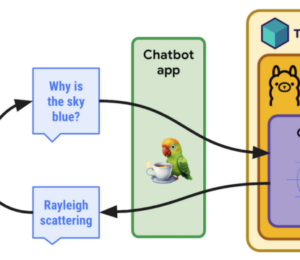
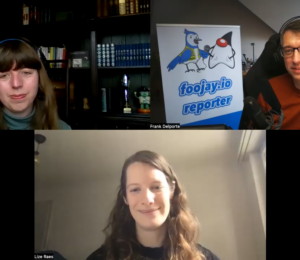
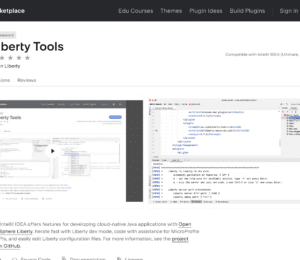
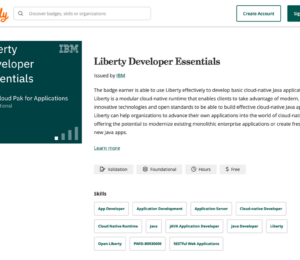
Comments (0)
No comments yet. Be the first.